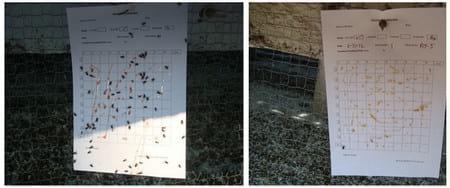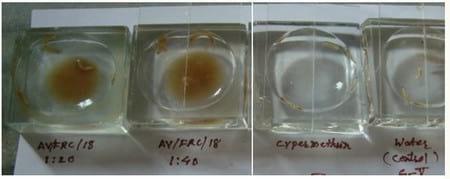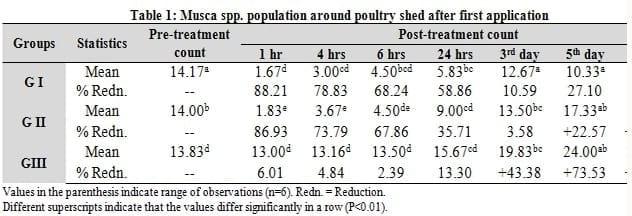Efficacy of Herbal Fly Repellent Product (Keetguard Liquid) to Control Musca Domestica Population in Poultry Egg Layer Farm
The housefly Musca domestica L. is recognized as a public health pest causing a serious threat to human and livestock by vectoring many infectious diseases. Chemical control method commonly used against this pest, though effective, has some major disadvantages, such as development of insect resistance and bioaccumulation. Therefore the efficacy of a herbal fly repellent Keetguard Liquid (supplied by M/S Ayurvet Limited, Baddi, H.P., India) was evaluated in vivo on the layer farm as well as in vitro. For in vivo trial the keetguard was used at the concentrations of 1:20 (Group-I recommended for application on body) in one shed and 1:40 (Group-II, recommended for application in premises) in another shed. Another shed kept as control (Group-III) was sprayed with plain water. The herbal fly repellant product was assessed for fly repellent and larvicidal effect and for its efficacy to minimize the count of larvae. In both the treatment groups, the fly repellency recorded during first 2-6 hrs was satisfactory. However, the fly population observed at the end of the week was encouraging in group-I due to its larvicidal effect. The probit analysis to draw Effective Concentration 50 (EC50) showed 43.66 ml/lit as EC50. The in vitro comparative efficacy study was conducted on third stage larvae of Musca spp. divided equally in 4 groups and exposed to 1:20, 1:40 (two different concentrations) of KEETGUARD LIQUID, a standard pyrethroid insecticide ‘Cypermethrin (1%)’ and control (plain water) respectively as group-I: 1:20 concentration of Keetguard liquid Group-II: 1:40 concentration of Keetguard liquid, group-III: standard pyrethroids insecticide ‘Cypermethrin (1%) and group-IV: control (plain water). In invitro study, higher efficacy (95 %) was recorded in group-I as compared to group-II (66.66%) and the standard insecticide-Cypermethrin-1% (100%) while similar trend of efficacy (90.69% in G-I and only 65.76% in G-II) was observed during in vivo field experimentation. The plant based herbal product Keetguard is efficacious as a fly repellent against house fly Musca spp. in egg layer poultry farm in both 1:20 & 1:40 dilution. In addition, it also has larvicidal potential against 3rd stage of larvae of Musca spp. considering the detrimental effects of chemical fly repellents and insecticides on the environment and human health, Keetguard Liquid was found better option for control of fly population in and around poultry layer farms.
Key words: keetguard liquid, fly repellent, larvicidal, ectoparasiticidal, herbal
The experiment was conducted in a farm near village Yewat, Dist. Pune having huge fly population suitable to undertake the experiment on efficacy of herbal fly repellant Keetguard liquid. The environmental temperature and relative humidity at farm premises was recorded during the period of experiment between 26.6-30.8 o C and humidity between 45-67 per cent. At this farm, three layer sheds caged with 10 thousand layer birds placed wide apart (100 feet) from each other with sufficient quantity of fresh manure underneath and having approximately identical fly population were selected for the present study. The repellents were applied to the area under (dropping area) and around the sheds by using power spray so that the spray reaches to the side mesh and entrances and tested against Musca spp. on the droppings, mesh, grills, grass and other objects and places where these flies were flying freely in the area as shown in figure 1.

Experimental groups
The three selected sheds were marked as three different groups for the study
Group I: Shed treated with Keetguard liquid @ 1:20
Group II: Shed treated with Keetguard liquid @ 1:40
Group III: Control group (Shed treated with plain water)
The product Keetguard liquid comprises of oil of herbs viz. Eucalyptus globulus, Cedrus deodara, Pinus longifolia & many others in a fixed concentration, which has got proven insecticidal, repellant and larvicidal efficacy.
A day before starting actual experiment, a pilot trial was conducted to select a best fly base (viz. paper sheets, white gonies, grass sticks etc.) or bait (viz. coloured sugar, egg albumin baits, syrup-soap baits etc), its position (viz. vertical/horizontal/ hanging/ fixed etc.) and location (viz. under/ sides of the shed) around the shed to assess maximum fly population per unit area at three different timings at an interval of 3 hrs throughout a day. Finally, syrup-based baits were preferred and applied on 8 the plain papers / fly sheets. These fly sheets were hanged at the side mesh of each shed so as to get the maximum access to flies in the premises and those escaping – newly emerged imagoes. The method was adopted on the basis of preference by the flies.
The stock herbal preparation which is sticky, brownish-orange coloured liquid presented in 250 ml plastic bottle was first poured in a plastic jar containing 1 lit of clean water and mixed thoroughly with a clean wooden stick to ensure proper and complete mixing of the drug. Then such stock solution was used to prepare working / spray solution of desired concentration i.e. 1:20 and 1: 40 respectively.
Following parameters were estimated to evaluate the efficacy of the product.
Total six baited fly sheets (three on either side) were hanged around the shed and kept undisturbed for one hour to settle on the flies as shown in figure 2. The snap shots of all six fly sheets, hanged around each shed, and were taken after 1 hour of its application. Fresh fly sheets were applied and the procedure was repeated 1 hour before every observation. The observations were recorded at 1 hour, 4 hours, 6 hours, 1 day, 3 days, 5 days and 1 week after the treatment. The numbers of flies present on each sheet at the end of an hour were counted on the 15’’ screen of LCD monitor (Kirby, 2008).

The larvicidal activity was assessed by in vitro and on field studies.
In vitrolarvicidal activity of Keetguard liquid was undertaken to evaluate two parameters viz. EC 50 and comparative efficacy.
The in vitro study was conducted on twenty number of 3rd stage larvae of Musca spp. to evaluate effective concentration of Keetguard liquid by exposing the larvae to a series of 3 concentration of the compound in distilled water (25, 50, 75 ml/L). The larvae were exposed to different concentrations for 60 minutes and percentage mortality was calculated. The probit analyses test was performed to find out the EC 50 value on the basis of log regression and graph method (Finney.D.J and Stevens. W.L, 1948 and Finney. D.J, 1952)
The in vitro comparative efficacy study was conducted on third stage larvae of Musca spp. divided equally in 4 groups and exposed to 1:20, 1:40 (two different concentrations) of KEETGUARD LIQUID, a standard pyrethroid insecticide ‘Cypermethrin (1%)’ and control (plain water) respectively as
Group-I: 1:20 concentration of Keetguard liquid
Group-II: 1:40 concentration of Keetguard liquid
Group-III: standard pyrethroids insecticide ‘Cypermethrin (1%)
Group-IV: control (plain water)
These larvae were later kept for pupation and the number of flies emerged were recorded as shown in Figure 3. Cypermethrin is a synthetic pyrethroid used as standard insecticide in large-scale commercial agricultural applications as well as in consumer products for domestic purposes (Kirby, 2008).

The droppings from middle layer of manure from all the three sheds under study were collected in a plastic jars of the volume of 3”x3”x3” and this volume was considered as unit volume. The samples from all groups under study were collected before an hour and after 24 hrs of application of the test compound. After collection, these droppings were mixed with sufficient quantity of water and filtered to isolate the larvae as shown in figure 4. The larval population of the Musca spp. per unit volume of the droppings were counted and compared.
The data of fly counts was properly recorded, organized and analysed statistically by using completely randomized design (CRD-equal) described by Snedecor and Cochran (1989) and software designed by Jangam and Thali (2001) WASP - Web Agri Stat Package (http://www.icargoa.res.in/wasp/index.php) to draw the conclusions and interpret the results.
Fly repellent activity against Musca spp. after first application
The results for the effect of compound on the population of flies after First application on day 1(1 hr, 4 hrs, 6 hrs and 24 hrs), day 3, day 5 and day 7 are summarized in Table 1
The post treatment count of flies on day 1was found to be 1.67, 3.00, 4.50 and 5.83 per unit area after 1 hr, 4 hrs, 6 hrs and 24 hrs and 12.67, 10.33 and 6.33 at day 3, 5 and 7 post applications respectively for Group I. In Group-II and III, the count was 1.83, 3.67, 4.50, 9.00, 13.50, 17.33, and 19.83 per unit area and 13.00, 13.16, 13.50, 15.67, 19.83, 24.00 and 26.00 flies/UA at 1, 4, 6, 24 hrs, 3rd, 5th and 7th day post application respectively.
With earlier concentration, the repellency was high on the day of application particularly during first 4-6 hrs both in case of group I and group II as only the available adult population was exposed to the repellent. The level of aroma of the herbal formulation was gradually decreased after 6 hours of application and the fly population gradually started increasing after 6 hrs both in Group I and II but was still considerably lower as compared to pre-treatment values. There was significant (P<0.01) decrease in the flies’ population in group I and group II after 24 hrs, but the population increased significantly (P<0.01) in Group III.
However, at 5th day and at the week end (7th day) after application, the level of fly population was again decreased in Group I. This may be the result of the larvicidal effect of the formulation which was sprayed on the manure (on droppings of the birds) under the sheds. The larvae came in contact with the formulation might have failed either to moult or pupate. The batch of flies expected to be emerged during this phase failed to develop. Thus it finally resulted in lowering the fly population. However, the population of flies increased significantly (P<0.01) in Group II and Group III. The increase in population may be due to decreased aroma in Group II.
Certain plant leaves have fly repellent and feeding deterrent activity against Musca domestica in Ethiopia (Wimalaratne et al. 1996). It has direct impact of mortality, also several secondary impacts on oviposition, repellence and antifeedancy (Pavela 2008). Similar results were found against mosquitoes & flies (Watanabe et al., 1993), livestock ticks (Lwande et al., 1999), house flies (Singh et al., 1991).
In vitrolarvicidal activity of Keetguard liquid was undertaken to evaluate two parameters viz. EC 50 and comparative efficacy.
The in vitro study was conducted to evaluate effective concentration Keetguard liquid by exposing twenty number of 3rd stage larvae of Musca spp. to a series of 3 concentrations of the compound in distilled water. The highest mortality of 85 % was observed at the 75 ml/L concentration followed by 55 % mortality at 50 ml/L concentration, 15 % mortality at 25 ml/L concentration of the test compound, as observed after 60 minutes. The probit analysis test was applied to find out EC 50 value on the basis of log regression and graph method and given in Table 2. The EC 50 calculated by using probit analysis was found to be 43.66 ml/L.
The In-vitro larvicidal efficacy of Keetguard liquid on larval count of Musca spp. and its further development is represented in Table 3. Four larvae from group-I, one from group-II and 5 from group-III were found dead after one hr of treatment while there was no mortality in control group-IV.
The larvicidal action of different concentrations is presented in Table 4. The larval population of the Musca spp. in the droppings was 21.50+1.57 and 24.33+2.16 before application of the test compound which was significantly (P<0.01) reduced to 2.0+0.37 and 8.33+0.92 at 24 hrs after treatment indicating 90.69 per cent and 65.76 per cent reduction in the population of larvae in the group-I and group-II respectively. However, in the control group, there is 15.7 % increase in the larval count after 24 hrs from 21.00+1.65 to 24.30+1.45. These results indicate that keetguard liquid has got larvicidal action at both concentrations but the effect is more pronounced in Group I at the concentration of 1:20. The larvicidal effect of herbal fly repellents were also reported by Khater et al., (2009), Oyedokun et al. (2011) and Jesika (2012). In some studies also, it was confirmed that some essential oils, such as that extracted from cedarwood (Adams, 1991; Grace et al., 1994), Litsea cubeba (Lin and Yin 1995), and cinnamo- mum spp. (Lin and Yin 1995), were repellents to termites. (Eisner et al., 1986) also confirmed that the all the known botanical/herb based fly repellants/ feed deterrents occur in varying proportion in wide range of herb extracts volatile or essential oils. (Campbell, 1983) also established the fly repellency or feeding deterrence properties of terpentenoids.
Authors are thankful to Dean, Bombay Veterinary College, Parel, Mumbai, Maharashtra, India for providing infrastructural and laboratory facilities to conduct the trial.
Bhatia B. B., K. M. L. Pathak, and D. P. Banerjee. 2006. Text book of Veterinary Parasitology. 2nd Edn, Kalyani Publishers. Ludhiana. pp: 248-49.
Crespo D., C. Roberto, E. Lecuona, and A. Jerome. 1998. Biological Control: An Important Component in Integrated Management of Musca domestica (Diptera: Muscidae) in Caged-Layer Poultry Houses in Buenos Aires. Argentina. Biological Control. 13:16–24
Campbell M. M. 1983. A test of repellency to non-biting flies and a comparison of repellants using Musca domestica L. Pestic Sci. 14:199-212.
Dales M. J. 1996. A review of plant materials used for controlling insect pests of stored Products. National Resources Institute. UK. 65:1-84.
Eisner T., M. Deyrup, R. Jacob, and J. Meinwald. 1986. Necrodol: anti-insectan terpenes from defensive secretion of carrion beetle (Necrodes surinamensis). J Chem Ecol. 12:14.
Finney D. J., and W. L. Stevens. 1948. A table for the calculation of working probits and weights in probit analysis. Biometrika. 35(1-2):191-201.
Finney D. J. 1952. Probit Analysis. Cambridge, England, Cambridge University Press.
Geden Christopher J., 2012. Status of biopesticides for control of house flies. J Biopest, 5(Supplementary), pp: 1-11.
Grace J. K., and R. T. Yamamoto. 1994. Natural resistance of Alaska-cedar, redwood, an teak to Formosan subterranean termites. J Fors Prod, 44(3):41-45.
Isman M. 2000. Plant essential oils for pest and disease management. Crop Protection, 19(8-10):603-608.
Jangam, A. K., and P. Thali. 2001. WASP- Web Agri StatPackage.http://www.icargoa.res.in/wasp/index.php.
Jesika M. 2012. Mixed Flower Waste Extract as Larvicides against Musca Domestica. Open Access Scientific Reports, 1(12):1-3.
Kant R., and R. M. Bhatt. 1994. Field evaluation of mosquito repellent action of neem oil. J Malar.31:122–125.
Khater Hanem, F. Y. Mohamed, Ramadan, S. Reham, and E. L. Madawy. 2009. The lousicidal, ovicidal, and repellent efficacy of some essential oils against lice and flies infesting water buffaloes in Egypt. Local publication, Department of Parasitology, Faculty of Veterinary Medicine Benha University, Moshtohor – Toukh, 13736. Egypt.
Kirby, 2008. Fly Management Handbook A Guide to Biology, Dispersal, and Management of the House Fly. The Connecticut Agricultural Experimentation Station. Bulletin 1013.
Lin T. S., and H. W. Yin. 1995. Effects of Litsea cubeba press oils on the control of termite Coptotermes formosanus Shiraki. Taiwan For. Res. Inst. New Series. 10:59.
Pavela, R. 2008. Insecticidal Properties of Several Essential Oils on the House Fly (Musca domestica L.). Phytotherapy Research, 22:274-278.
Oyedokun A. V., J. C. Anikwe, F. A. Okelana, I. U. Mokwunye, and Azeez O. M. 2011. Pesticidal efficacy of three tropical herbal plants’ leaf extracts against Macrotermes bellicosus, an emerging pest of cocoa, Theobroma cacao L., J Biopest. 4(2):131-137.
Perry A. S. 1958. Factors associated with DDT resistance in the house fly Musca domestica L. Proceedings, 10th International Congress of Entomology. 2:157-172.
Snedecor, W G., and C. G. William. 1989. Statistical Methods, Eighth Edition, Iowa State University Press.
Singh D., Singh A.K. 1991. Repellent and insecticidal properties of essential oils against housefly, Musca domestica L. Insect. Sci. Applic.12:487-491.
Sunita F., and B. Lalijee. 2008. Study of Various Extracts of Ayapana triplinervis for their Potential in Controlling Three Insect Pests of Horticultural Crops.Tropicultural. 26(2):119-124.
Thomas G. and J. B. Jespersen. 1994. Non-biting Muscidae and control methods. Rev. Sci. tech. off int. Epiz. 13(4):1159-1173.
Varzandeh M, W. N. Bruce, and G. C. Decker. 1954. Resistance to insecticides as a factor influencing the biotic potential of the house fly. J Eco Ent. 47:129-134.
Watanabe A.K., Shono Y., Kakimizu A., Matsuo, Saton A., Nishimura H. 1993. New mosquito repellent from Eucalyptus camaldulensis. J. Agric. Food Chem. 41:2164-2166.
Wimalaratne P.D.C., K.N. Slessor, J.H. Borden, L.J. Chong and T. Abate. 1996. Isolation and identification of house fly, Musca domestica L., Repellents from pepper tree, schinus molle L., J. Chemical ecology. 22(1):49-51.















.jpg&w=3840&q=75)